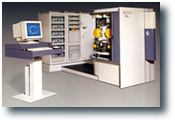
Some Details about the Manufacture of MiniDiscs

Dr. Franz Gassmann, Rewritable Disk Group Manager at Balzers Process Systems
in Liechtenstein, kindly answered several questions about the
manufacture of blank MiniDiscs. Presented here is a summary of our
telephone conversation. -Eric Woudenberg, February 1997
Could you briefly describe your machines?
Our SDS 100 and Sprinter machines are used for the manufacture of
MiniDiscs and other Magneto-Optical media. They are installed in
laminar flow clean room environments and fed with substrate blanks.
Each blank takes 7.2 seconds to cycle through the machine (up to 500
per hour). In this time they move through 6 sputtering chambers and
receive 4 layers of material. In the sputtering chambers a plasma is
formed. Out of this plasma Argon ions are accelerated against a target
(cathode) consisting of the desired layer material. Through the ion
bombardment, molecules are liberated and deposited on the disc which
lies opposite the target. In this way a thin layer is formed. The
layer thickness is determined by 3 things: the gas flow rate, the
electrical power, and the time of deposition.
Inside the machine, the first 3 chambers all deposit silicon
nitride, building up a heavy layer, the succeeding 3 chambers deposit:
a terbium- iron- cobalt- chromium layer (the actual recording medium),
a second silicon nitride layer, and an aluminum- titanium reflective
layer. The silicon nitride layers effectively sandwich the recording
layer, sealing it from the environment. After this the discs exit the
machine and go to lacquer coating equipment (made by other
manufacturers) such as is used in the manufacture of CDs.
If the chambers of your machine are under high
vacuum, how do the discs enter and exit?
There is a load lock which allows the discs to enter without
compromising the vacuum.
How much do your machines cost?
About 1.5 million Swiss Francs.
What do individual MDs cost to manufacture?
About $2 each, almost half of that is the packaging (cartridge shell).
Is there any difference in the cost of manufacturing 60 minute
blanks versus 74 minute ones?
None at all.
Why are there two sizes of MDs?
Originally they had trouble making the 74 minute ones.
What's the difference between 60 and 74 minute blanks?
The pregroove wobble is at a higher linear frequency on the 74 minute
blanks, causing the disc to spin slower and therefore record more
information in the same linear space.
Have you heard about any longer duration MDs?
No, other than Sony's new high capacity MD
data discs.
Would it be possible to make longer duration Audio
discs?
Not without a technology change. Perhaps it is possible to get a
little bit more information on, but how much demand would there be for
discs with a few minutes more capacity?
Well, a 100 minute disc would be nice.
No, I doubt it is possible, that would be a
33% overall capacity increase, a relatively large amount.
What are some of the quality control issues in making
discs?
Well, the sputtering chambers accumulate heavy deposits of material on
their inner surfaces. After 2 to 3 days of running these deposits can
build up to the point where little particles begin to flake off and
can land on the disc surface. When this happens, the layers being
deposited on the discs start to show irregularities. When these
surface irregularities occur they are readily detected since each disc
undergoes an automatic optical quality check after exiting the
machine. Discs failing the optical quality check are rejected
automatically by the disc handling equipment. Normal procedure is to
clean the machine every 2 to 3 days so that the reject count does
not begin to climb.
What is the overall reject rate during manufacture?
We state 3% for our machines.
Are there other kinds of problems that can occur, besides the
surface irregularities?
Other problems can occur such as incorrect layer thicknesses caused by
wrong settings, improper gas flow rates and the like. However our
machines detect these conditions and provide an alert. In addition,
during normal manufacture a small sampling of discs have their entire
recording area tested to ensure that the recordable signal to noise
ratio of the discs being produced remains at acceptable levels.
How many of your machines are used in MD production?
Up through January 1997 there have been 20 systems delivered for
MiniDisc production, all to Japan, except for 2. Ten more were
delivered for the production of rewritable data discs. We expect to
ship at least 10 additional systems for MiniDisc production this year,
again, mainly to Japan.
How many MiniDisc production plants are there?
Well, there are only four main manufacturers of MDs right now, all in
Japan. There are two small manufacturers outside Japan as well.
Do you need to be a MiniDisc system licensee to make MDs?
Yes.
Where do the substrate blanks come from?
Each of the above manufacturers has the ability to make their own MD
stampers and substrates.
How can the MD manufacturers differentiate their products? Can
they base it upon error rates?
No, they can't really do that. It's primarily just through differences
in packaging.
Well, thank you very much for your time!
You're quite welcome, glad I could be of assistance.
A few details on MiniDisc Manufacture and the Sprinter 750

Stephan Voser, Project Lead for
the Sprinter
750, kindly granted a telephone interview concerning the
current state of MiniDisc manufacture. This is a summary of our
conversation.
-Eric Woudenberg, December 1998
The new Sprinter 750 reduces manufacturing costs considerably.
Could you tell us roughly how much it costs to make an MD blank with it?
Well, the cost to make just the sputter coated blank with our new
machine runs about 5 yen per disc, but to this you must add the
lacquer coating, upper surface lubricant, hub, cartridge, jacket,
label and packaging. After all is said and done, a ready to sell blank
costs less than 100 yen to make.
How is the lubricant applied?
There are two main
methods. One is to apply a silicon oil and solvent mixture in a spin coating
process, the other uses a pad embedded with lubricant paste that is
stamped against the upper surface.
Could you briefly explain the Sprinter 750's twin track magnet
system?
Well, as you know, sputtering involves accelerating
Argon ions against a target of the desired coating material. From this
bombardment, target molecules are liberated and deposited on the disc
(which sits opposite the target and about 40mm away). One problem in
this coating process is that the target gets eroded rather unevenly
and stops producing an even coating on the disc long before it is
really used up. The twin track system uses a complex arrangement of
rotating magnets behind the target to help ensure that the target is
used up gradually and evenly. This allows us to get 3 to 7 times more
discs per target.
We are seeing "high grade" blanks on the market. What possible
quality differences can there be between blanks?
The primary
difference is in the quality of the cartridge shell; high quality
blanks will have a very rigid and durable cartridge. In terms of the
discs themselves, the coating process for all blanks is
identical. However, MD substrates (uncoated discs) made in the
beginning of a stamping run (say the first 1000) will have a better
land/groove shape than the [10's of thousands of] discs produced in the
remainder of the run. In terms of audible differences however, there
will be none.
Are there differences between the MO recording layers in the blanks from
various makers, or is everyone using the same alloy?
There are slight differences in recording layer materials. There are
just a few principle suppliers of the alloy but others are trying to get into the
market. The alloy is quite expensive and the desire is to minimize
cost while maximizing carrier to noise ratio.
In Gassmann's Minidisc article in Layers he gives the
specs for MD Data II. Do you know the status of this system?
Well, it's apparently working in the laboratory, but getting an
economical version into the marketplace has so far proven
elusive.
Is worldwide MD production still increasing, or has it
plateaued?
Blank production appears to be saturated for this
year, but we are expecting an increase next year due to Sony's European and US
marketing push and the general upward trend in MD use.
How many blanks are produced, worldwide?
In 1997, 120 million blanks were produced, in 1998, 200 million.
That covers all my questions, thank you very much for your time, Mr. Voser!
Not at all, thank you for calling.
Further Reading
See also an Optical Disc News article from 1998 on the use of
Balzer's equipment in Minidisc manufacturing.


